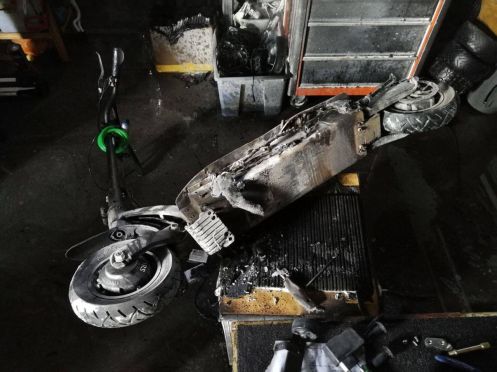Whatsapp Us Today! Join Now

Sgscooters recently spoke to Falcon PEV, an industry leader in electric mobility vehicles, about a recent e-scooter explosion in their office during the Christmas period last year.
Falcon PEV has always placed great emphasis on safety when it comes to having safe procedures in the testing and repairing of e-scooters. Safety is a buzzword that everyone touts but not many pro-actively practice. As Victor from Falcon PEV admitted, they became one of such complacent “safety advocates” after many years of accident-free operations.
Throughout their operations, they have always maintained a debris free zone in the workshop with the right protective gear like anti-static gloves, covered toe shoes, proper equipment etc. Fire extinguishers were placed all over the workshop and proper handling and disposal procedures were in place for all discarded Lithium Ion batteries.
However, sometimes the best laid safety plans and the most experienced technical personnel could never be prepared for a freak accident like what happened during Christmas 2017.
A highly charged Li-Ion battery from a powerful e-scooter started hissing, smoking and exploding at Falcon PEV’s workshop a few days before Christmas 2017 like how our discipline master in school used to do. The New Year’s Eve fireworks came early to their office.
Thankfully, the explosion was very isolated and was immediately extinguished by their technicians. As Victor reflected, the good news is that they survived with minimal scarring. The bad news is that they now have a burnt carcass of an e-scooter, a couple of traumatised technicans and some bruised egos.

All things considered, they averted a potential disaster but it serves as a lesson for all of us. Whether you are a professional workshop or an enthusiast DIYer, we should not ever for a moment be complacent and let our guard down when handling Li Ion batteries. Falcon PEV has taken steps and measures to tighten their safety procedures where they saw lacking.
Our mission at Sgscooters is to share those lessons with the rest of the world and encourage any e-bike or e-scooter retailer, workshop, DIYer and enthusiast to take the necessary precautions when repairing their e-scooters and e-bikes.
Bloated batteries, batteries that are visibly torn, water logged or deformed pose a safety concern. If you encounter such a case, disconnect the battery and place them on a stable solid non-metallic surface. Dispose of these batteries at a proper disposal center.

When your e-scooter has been through a nice shower, always check if the battery has taken in water. If the battery does not seem to be damaged, disconnect the battery, remove it from the scooter and place it on a stable non-metallic surface to dry out. If you have silica packets, place the battery in a box of it to absorb the moisture. Clean out the rest of your e-scooter and let dry for at least 3 days before reconnecting the battery back into the scooter.
Having a sand bucket nearby when dealing with e-scooter batteries is handy. This is not for you to build sandcastles but an effective way to put out Li ion fires. As soon as you see any smoke coming from the battery, pour the sand directly onto the battery. It will be more effective than a regular powder based extinguisher. Foam based extinguishers work just as well so always have either of those 2 within arm’s reach when handling damaged lithium ion batteries.
When replacing a battery into the battery compartment of an e-scooter, always check for any sharp foreign objects or debris before inserting the battery. During a repair job, screws or other metallic shavings could have fallen into the battery compartment. When inserting the battery, sharp objects may penetrate the battery and this is what happens if sharp objects penetrate a li-ion battery pack (turn on the volume to hear the hissing):
You may have heard of hoverboard batteries exploding at random a few years ago. Most of these were caused by sub-standard non-certified batteries which are sold at dirt cheap prices.
UL certified batteries are stable and safe to use in most conditions. Quality battery cells from Samsung, Panasonic, LG and Sanyo are generally more trusted than China-made li ion cells. Read our previous article to understand why its important to ensure that the cells that you are using are from a trusted qualified source. Here is what happens when a sub-standard li ion battery explodes:
These are just 5 simple tips for you if you do want to do your own repair work on your e-scooter. We at Sgscooters strongly encourage anybody who is working with ebike and escooter batteries to follow these safety tips and some common sense (well-lit room, easy escape routes etc.). The important thing to understand is that MOST Li-ion batteries are actually very stable and safe to handle especially when the batteries are from a quality source.
If you aren’t confident of fixing your e-scooter, then it would be best to bring it to a quality e-scooter service workshop.
All orders are shipped in 1-2 business days and arrives within 1 week.
Free Shipping on local orders
Experienced Before and After Sales Support